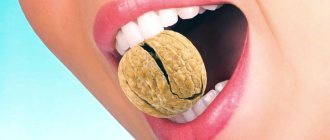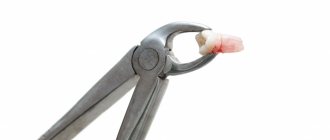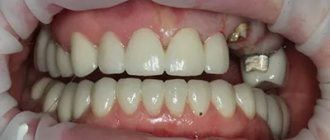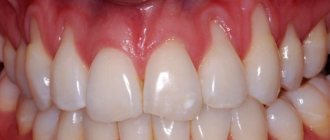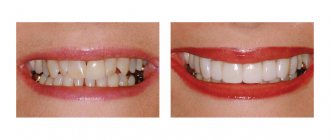05.08.2021 241
Some patients ask whether pain may appear after cleaning the canal. The concerns are understandable - since the canal has been cleaned, there is no nerve in the tooth. Theoretically, he should not get sick and react to external stimuli. How are things going in practice? Let's look at this issue later in the article.
What is the canal cleaning procedure?
Before moving on to the issue of pain, let’s define what the root canal cleaning procedure itself is. Typically, such surgery is performed because the root is severely damaged. There are two reasons - inflammation or the development of infection.
Most often, root cleaning is performed in patients whom doctors have diagnosed with pulpitis or periodontitis. Cleaning and filling in such a situation are necessary in order to stop the destruction processes and save the tooth. The only alternative is deletion.
During the cleaning process, the soft tissues of the oral cavity are also affected. And here it is important to understand one of the central features of the procedure. Cleaning is done on already inflamed tissues. Since the inflammatory process usually affects large areas and spreads quickly, it will continue to occur for some time. Then the state will fade and stabilize. This usually takes several days.
Due to residual inflammation, the tooth may actually hurt for some time - this is normal. At the same time, the pain itself has a dull, aching character. It is not strong and most patients do not even have to take analgesics. Usually the discomfort intensifies slightly as the evening approaches.
If the patient’s body is in normal condition and nothing affects its regenerative abilities, after two or three unpleasant sensations begin to subside. The feeling of discomfort lasts longer, especially if the operation was traumatic or you have a complex root structure.
You will have to put up with pain much longer if, for some reason, you put off visiting the dentist until the last minute. In this case, the inflammation will become more and more severe, covering large spaces. Also, the rehabilitation process is extended if the patient has any systemic diseases of the body.
What materials are used to fill canals?
The main requirements for such filling materials are dense, hermetically sealed filling of the canals, chemical inertness (the material should not dissolve under the influence of body fluids), radiopacity (it should be clearly visible in the picture). Today, the following types of materials are used for filling dental canals:
- Solid fillers (fillers).
These include gutta-percha (a latex processing product), silver and titanium pins. Silver pins have recently been rarely used, since despite their good antibacterial properties they have a significant drawback - they do not provide complete tightness. - Polymer and natural pastes (sealers)
. A more preferable option is polymer sealers, which adhere better to the walls, do not stain dental tissue and do not dissolve when interacting with tissue fluids. - Glass ionomer cements.
Good adhesion and radiopacity, high biocompatibility and minimal shrinkage are the main positive qualities of such materials. They also have significant drawbacks: low strength, which is why such fillings are short-lived and not designed for serious functional loads. - Calcium hydroxide cements
. Non-toxic, biocompatible, radiopaque materials that exhibit minimal shrinkage, are easily removed if necessary and have bactericidal properties. However, they are considered not too strong and can break under heavy loads on the dental crown. - Polydimethylsiloxanes
. Modern reliable sealants with good therapeutic and operational parameters. Perhaps their only drawback is that this is a new product on the dental market and experience in using such materials has not yet been accumulated. There is no reliable information yet about the experience of patients after such treatment.
In case of inflammation of the tooth canals, the dentist selects the treatment individually, taking into account the type of dental unit, the number and shape of the roots, the patency of the root canals and the further plan for restoring the crown. Taking these factors into account, the filling material is also selected. Many specialists combine materials to achieve optimal characteristics and tightness of closing cavities. Filling techniques
Just 10-20 years ago, the main method of filling dental root canals was to fill them with one type of cement. This is a very simple and not labor-intensive method, but for the patient it has a lot of disadvantages: the channels are filled poorly and unevenly, voids appear in which microbial infection can develop. In addition, such cements quickly shrink and the canals soon have to be re-treated.
Modern dentistry offers completely different filling methods:
- Depophoresis
is the hardware introduction of medicinal and filling materials into the root canal. The technique allows you to effectively fill even curved and hard-to-reach canals. - Obturation with thermophiles
(plastic carriers coated with gutta-percha). A fast, fairly simple and reliable method, which still has the disadvantage of the possibility of material being removed beyond the root tip. - Filling with gutta-percha pin
. - Lateral condensation
is a dense filling of the canals with gutta-percha pins coated with a hardening sealer. A fairly reliable method, however, when using it there is a high risk of tooth root fracture. - Thermomechanical
(sometimes also called rotating condenser sealing) condensation. Recently, it has been used very rarely due to the high risk of complications. - Vertical condensation of heated gutta-percha
. A rather complex and lengthy, but at the same time reliable and durable filling method. - Injection filling with hot gutta-percha
. - Injection of heated gutta-percha
using the continuous wave method. One of the options for vertical condensation, characterized by greater simplicity and at the same time sufficient reliability and tightness of filling the channel. - Thermoplastic injection
of hot gutta-percha. A simple and fast method, which, however, does not always make it possible to densely fill the lateral tubules. - E&Q Plus
is a mixed technique using an injection gun to inject gutta-percha into the canal.
If you have a problem similar to that described in this article, be sure to contact our specialists. Don't diagnose yourself!
Why you should call us now:
- We will answer all your questions in 3 minutes
- Free consultation
- The average work experience of doctors is 12 years
- Convenient location of clinics
Single contact phone number: +7
Make an appointment
What to do if your tooth hurts after root canal cleaning
So when should you start worrying if your tooth hurts after root canal cleaning? The first reason to sound the alarm will be prolonged and severe pain. This gives reason to think that for some reason complications began to develop.
There are several key warning signs that should make you see a doctor:
- The pain does not go away for a long time.
- Instead of calming down, there is a constant increase in pain.
- Instead of a dull and aching pain, the pain becomes sharp, and a sensation of pulsation appears in the tooth.
- The gums become very swollen, and significant tissue swelling occurs.
- The temperature rises and the patient's general condition becomes worse.
In this case, timely consultation with a doctor becomes the key to maintaining your health. This also allows you to prevent the removal of a tooth for which the dentist cleaned the canals.
Types of pain and what they mean
There are different types of pain. Experts highlight the following:
| Variety | Meaning |
| When biting, pressing, tapping or pressing | An inflammatory process takes place. Healing should begin within 1-2 days. Intensification of negative processes when biting indicates the need for repeated cleaning or a medical error. |
| Acute pain | If the tooth hurts severely and the pain persists for more than 3 days and does not subside, then this symptom may indicate infection, the remainder of the tooth, or an individual characteristic of the body. Seeing a doctor in this case is necessary. |
| It's a dull pain | If the tooth aches, this indicates inflammatory processes, a slow process of tissue restoration, or the need to repeat the canal cleaning procedure. |
| Throbbing sensation | The tissue healing process is going on; a piece of tooth or instrument remains in the canal. |
Reasons for the development of complications
The very cause of severe pain in the case of each patient must be considered separately. Among the most common sources of such pathology may be the following:
- Incorrectly chosen treatment method, gross mistakes made.
- The channel was not cleaned correctly.
- The doctor left foreign objects inside the canal, did not clean out the tooth fragment, and broke the instrument.
- The patient had a sudden allergic reaction to anesthesia or root canal filling agents, or various medications taken during treatment.
- The filling was placed poorly.
- Severe periodontitis developed and gum damage began.
- The canal walls were perforated during the cleaning process.
- The root of the tooth has received any damage.
Against the background of all of the above, the inflammatory process can actively develop. It becomes the cause of severe pain experienced by the patient.
The temperature has risen
A rise in temperature to 37.2 after cleaning the channels is normal.
In some cases, after visiting a dental clinic, the patient’s body temperature rises to 37-38 degrees. After cleaning the canals, the body may react in a similar way, since there has been intervention in the tissue, as well as exposure to dental materials, which can be perceived by the immune system as foreign bodies.
Additional reasons that need to be taken into account in order to promptly seek professional medical help:
- The beginning of the inflammatory process.
- Attachment of a secondary infection.
- Injury to tissues inside the tooth, on the gums.
- Tooth canal cleaning was carried out during a cold.
The body can respond with an increase in temperature even if the patient has shown excessive emotionality before or during the procedure. A stressful situation for the body is expressed in these specific symptoms. The norm is a temperature no higher than 37.2 degrees, which lasts 1-2 days. All other cases are violations requiring medical supervision.
What to do if your tooth hurts after root canal cleaning
There can be many answers to the question of why a tooth hurts after root canal cleaning. For this reason, it is very important to pay attention to the characteristics of the individual patient’s body.
If you notice the first signs of the inflammatory process described in this material, you should consult a doctor as soon as possible.
The dentist carries out several basic actions:
- Collecting an anamnesis, taking into account the characteristics of the patient’s condition, the nature of the pain, medications taken, and personal characteristics of the body.
- X-ray of the affected tooth, examination of the condition of the gums, canals, assessment of the quality of the work performed.
- Opening the seal, re-cleaning, using disinfectants.
- Prescribing the patient a course of anti-inflammatory drugs and other medications.
Timely actions help to significantly reduce potential harm to the human body and ensure that the tooth can be saved.
In the clinic
In the most difficult situations, physiotherapy is indicated:
- ultrasound therapy (ultrasound waves have an analgesic and anti-inflammatory effect);
- laser therapy (has the same effect as ultrasound);
- electrophoresis of anesthetics (quickly and permanently relieves pain);
- centimeter wave and decimeter wave therapy (these ultra-frequency waves relieve inflammation and reduce swelling).
How to prevent pain and complications
Regardless of the field of medicine, doctors agree with a simple statement - it is much easier to prevent complications from developing at all than to treat them. There are a few simple recommendations that you should follow:
- Pay close attention to who is performing the operation on you. In our clinic, the task is performed by experienced surgeons who are well aware of all the features of the process. This ensures that mistakes are eliminated - the canal is filled correctly, and there are no fragments or dental instruments left inside.
- If you have previously had an allergy to any analgesics or anti-inflammatory drugs, tell your doctor.
- Don't put off visiting your doctor. The longer you leave a tooth untreated, the greater the risk of numerous potential complications.
- Ask how long the tooth hurts after root canal cleaning in your specific case. The doctor can make a prognosis based on information about the health status of a particular patient.
Also remember that if after cleaning the canals you have any signs of inflammation, you need to see a doctor as soon as possible. It is strictly forbidden to use self-medication, drugs without recommendation, or folk remedies. All this can only make the situation worse.
What can you do at home?
If toothache does not go away after the brushing process or causes serious discomfort, you should use medications or folk remedies to relieve symptoms. It is important to remember that any thermal effects on the area where dental intervention was performed are prohibited.
Drug therapy
To temporarily eliminate pain of varying severity, it is recommended to use some analgesics and anti-inflammatory drugs, such as Tempalgin, Baralgin, Nurofen, as well as Ketorol or Analgin. Before use, you should carefully study the instructions for use of the drug.
Traditional methods
Apply a cotton swab moistened with valerian tincture to the problem area.
In addition to medications, folk remedies help well. Pain or pus can be eliminated by applying a cotton swab dipped in lemon balm or valerian infusion to the damaged area. Clove or fir oil also helps well - apply 2-3 drops of it on a cotton swab. You need to apply it to the damaged area for 5-10 minutes.
Ice can be used as first aid, but the effect will be short-lived and mild. An alternative method of eliminating pain after cleaning the dental canals is massage of the auricle. It must be carried out from the side of the diseased tooth.
If fever is added to the pain, then in addition to traditional methods and medications, physiotherapy should be used. In this case, exposure to ultrasound or UHF helps well - after such procedures it is necessary to replace the filling and take an x-ray to monitor the condition.
Contact us for the right treatment
Our clinic employs dentists with extensive experience. They perform high-quality cleaning of dental canals and carefully ensure that the person does not experience any complications. We will also give all the necessary advice regarding the course of the recovery process, and recommend the necessary means to reduce pain and relieve inflammation.
We offer our customers competitive prices and special discounts. To get your first appointment and get professional advice, call the numbers listed on the website or leave a request.
WHY ARE COMPLEX TEETH DONE IN PARTNER-MED?
We know how to work!
We have orthopedic dentists with 8-30 years of experience!
We love to work!
We will give you a free consultation and tell you exactly how best to make your teeth better!
We are responsible for the result!
We work conscientiously and will make your teeth LIKE YOURSELF!
Standard activities after installation of the material
Do not drink or eat until the material has completely hardened, as it may crack or fall out completely. Also, food can get into the cavity of a molar or premolar. After a non-permanent filling, it is not recommended to eat soft food for the first 2-3 hours, and hard food for 10-12 hours. This will avoid a number of negative consequences. When chewing solid food in the future, you should use less of the side on which the filling was performed.
While wearing the material, hygiene rules must not be neglected. You should brush your teeth twice a day, and after eating, rinse your mouth with antiseptic solutions and floss. If the temporary material is installed for several months, it is recommended to use a brush with softer bristles during this period. To avoid possible complications, the material is removed on a strictly designated day.
Symptoms of needing root canals
If you experience prolonged pain from cold or hot water, lasting several minutes, you should suspect inflammation of the nerve in the tooth. The pain can increase gradually, occur after a filling is placed, or with severe tooth decay due to a cold, decreased immunity, stress, or hypothermia. If pain occurs when food hits a certain tooth, when you press on it or tap it with a spoon, then you can assume inflammation of the apical tissues around the root - periodontitis. Cleaning the canals, treating them with medication and filling them is necessary to prevent the spread of inflammation to neighboring areas. In severe cases, complications such as periostitis, osteomyelitis, abscess or phlegmon develop, the latter is treated in a hospital. If the nerve or gangrenous tissue from a tooth is not removed in time, the risk of losing the tooth itself increases over time.



